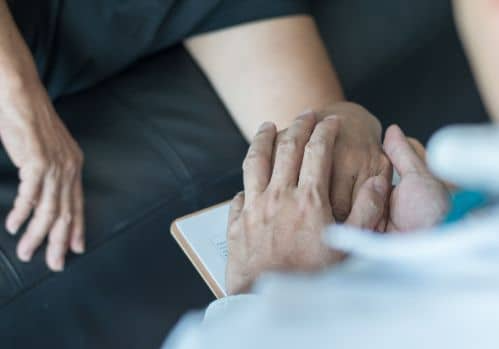Parkinson's Disease
What is Parkinson’s Disease?
Parkinson’s disease and tremor are the two most common neurological movement disorders that affect adults.
Parkinson’s disease can lead to depletion of dopamine, a neurotransmitter or chemical which sends signals around the brain.
Who Are Affected By Parkinson’s Disease?
Parkinson’s disease is the second most common neurodegenerative disorder after Alzheimer’s disease. It affects about 1% of people who are 65 years or over.

Many people can suffer from non-Parkinson's disease tremours such as:
- Occasional tremors in their hands (commonly known as physiologic tremors), or
- Hereditary conditions such as hereditary, benign essential tremors.
Causes of Parkinson’s Disease
The only confirmed cause of Parkinson’s Disease is genetic. This is referred to as “idiopathic”. This only accounts for 10% of all cases.
Other risk factors include exposure to pesticides and toxins.
How does Parkinson's Disease Affect The Body?
Parkinson’s disease causes the brain’s basal ganglia to deteriorate. This affects your motor control, learning, executive functions, behaviour and emotional functions.
The lack of dopamine affects how your brain's neurons communicate, and this loss of signal transmission movements loss and tremors.
Parkinson’s Disease Symptoms
Tremor is also associated with Parkinson’s disease, with nearly 80% of patients having some form of tremor at the initial diagnosis.
The symptoms of Parkinson’s disease can be classified into either motor or non-motor symptoms. Motor symptoms are symptoms that affect movement.
Motor Symptoms
The primary visible symptom of Parkinson’s is tremor (shaking), but other motor symptoms can include
- Muscle rigidity, difficulty starting a movement, slowness in movement (bradykinesia), and issues with posture and gait.
- Parkinson’s disease can also affect handwriting, causing it to be smaller than usual (micrographia).
- Patients with Parkinson’s disease may also speak more softly than they used to (hypophonia), and their facial expressions may not be very animated.
Non-motor Symptoms
Non-motor symptoms are symptoms of Parkinson’s disease that do not affect movement. Patients with Parkinson’s disease may experience non-motor symptoms, including
- mood changes,
- pain,
- fatigue and
- sleep difficulty.
- poor focus & thinking,
- loss of smell
Stages of Parkinson’s disease
Parkinson’s disease can take a long time to cause severe effects. A useful scale for the disease includes how the disease affects you:
- Non-motor observations like dementia, depression, anxiety and other mental ability and mental health-related issues. It also asks questions about pain, constipation, incontinence, fatigue, etc.
- Motor observations related to tasks and abilities such as the ability to speak, eat, chew and swallow, dress and bathe yourself if you have tremors and more.
- Motor examination to determine the movement-related effects of Parkinson's disease such as measuring how you speak, facial expressions, stiffness and rigidity, walking gait and speed, balance, movement speed, tremors, etc.
- Motor complications to determine the impact of symptoms like the amount of time you have certain symptoms each day and whether or not those symptoms affect how you spend your time.
Diagnosis of Parkinson’s Disease
The neurologist can diagnose Parkinson's Disease by
- taking a complete medical history,
- asking patients questions
- performing a neurological examination.
Pathology Tests can not diagnose non-genetic cases of Parkinson’s, but as many other diseases have similar features but require different treatments.
Some tests are needed to rule out other conditions or certain causes. These medical tests, as well as responses to drug treatment, may help to better evaluate the cause.
It is important to get an accurate diagnosis as soon as possible.
Treatments for Parkinson’s disease
Parkinson’s disease treatments are targeted at reducing the symptoms and use both medical and surgical approaches.
Research continues to search for ways to halt or reverse the brain degeneration associated with the disease.
Medications
- Medications to increase dopamine in your brain.
- Dopamine agonists create a dopamine-like effect in your brain
- Dopamine metabolism blockers so the body retains more dopamine
- Metabolism inhibitors slow your body's processing of levodopa.
- Adenosine blockers stop certain cells from using adenosine to support levodopa.
Lifestyle
Making lifestyle changes is essential in treating Parkinson’s disease. A regular exercise program helps to maintain abilities, increase mobility in joints, strengthen muscles and build up fitness in general.
Deep Brain Stimulation (DBS)
Stimulating areas using electrical signals to specific parts of the brain.
As Parkinson's disease progresses, the symptoms expand and intensify. Later stages of the disease often affect how your brain functions, causing dementia-like symptoms and depression.
About Our Movement Disorder Clinics
Management and treatment of Parkinson’s and other movement disorders can vary on the stage and severity of the disease, as well as its syndromic features.
In our specialised clinic, we provide patient-centred management, advanced therapy options as well as ongoing support for the patient and their families.
At NeuroNSW, we subspecialise our days into Parkinson’s clinics that solely focus on tremors, movement dysfunction and the diagnosis and management of Parkinsonian disorders.
If your patient wants a review of Parkinson’s or other tremor disorders that require a neurological consultation with Dr Baumann, please contact our practice.
Get in Touch
Once your referral is triaged, an appointment date and time will be made for you.
About Us
Neuro NSW provide multi disciplinary care and are a multi specialist practice. We provide extensive Neuro diagnostic testing and comprehensive Neurological assessment.
Get in Touch
- Mon - Thu
- -
- Fri - Sun
- Closed
- Public Holidays: Closed
- Closed from 22/12/2023 - 03/01/2024
- Emergency: Not
available
All Rights Reserved | Neuro NSW Brain & Spine Specialists






